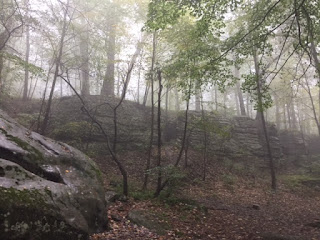Instead of saying that Fort Necessity National Battlefield is a yawn, let me say that it's one of only a handful of national parks or monuments in the state...and way more interesting than the Johnstown Flood National Memorial--which also belongs to the National Park Service. There's a much-neglected picnic area way off in the woods at this park; my kids and I had it entirely to ourselves. In the mists of the day and the seemingly total abandon, the picnic area was a little creepy. Here is a careful replica of the fort that the French burned down upon defeating George Washington at the Battle of Great Meadows in the summer of 1754. This part of the park is plenty crowded.
The French were retaliating for Washington's murder of a young French officer and ten or more soldiers at a "gloomy glen" on the craggy summit of Chestnut Ridge. Actually, it seems that Washington blamed the Seneca chief "Half King" for the murder, but to this day, the events at "Jumonville Glen" lay shrouded in mystery...which is only fair, for Jumonville Glen itself was shrouded in fog on the afternoon of our visit, bottom photo.
Click on this photo to enlarge it, as with any photo on this blog. Here is a tiny remnant of the road that General Edward Braddock hacked through virgin forest in his failed venture in 1755 to liberate "The Forks of the Ohio," from the French. "The Forks" are now known as Point State Park in downtown Pittsburgh. Is it strange to think that George Washington worked on behalf of the British Crown when he started the "Seven Years War," perhaps earth's first true "World War"?
Of course, here in America, we ignore the fact that the Seven Years War was a worldwide conflict. Here, we just call it "The French and Indian War." This is a better shot of the true Braddock's Road from Virginia to the Monongahela--which was largely developed into U.S. Highway 40, or "The National Road," in the 1800s.
It's certainly not as early as the Battle of Great Meadows, but the old inn on the grounds of the "national monument" is worth a visit. It received many a pioneer on the westward trek into the Ohio Country in the early 1800s. To my understanding, a "national monument" is the same thing as a national park, except smaller.
Click on this photo. Here again is that replica of the doomed old fort that a 20-something Washington threw together in haste when he realized that the French would come to avenge the cowardly murder of an officer and some of his men in a time of peace. It's called "Great Meadows" because the fort was erected in a large natural clearing, while everything around it was forest. In fact the French easily captured the fort because they were able to hide in the nearby woods and launch their attack from all sides.
From Fort Necessity, with its visitors' center and tour buses, it's a seven-mile drive to the remote spot on the summit of Chestnut Ridge where the actual murders took place. This, too, is part of the national monument. In contrast to the areas around the fort, which were crowded and developed, the area called "Jumonville Glen" is lonely and far-flung. We spent about 45 minutes there on an October Saturday, and in that time we had the whole place entirely to ourselves. Click on this photo to read the plaque's inscription. The events that transpired here are sometimes called "The Battle of Jumonville Glen," but a battle it was not. Whereas the French were careful to maintain a respect for human life and a desire for peaceful resolution at the later Battle of Great Meadows, what happened at Jumonville Glen was an ambush a slaughter.
This is Jumonville Glen as seen from the spot of the French encampment, so named for the commanding officer of the French soldiers, Joseph Coulon de Jumonville, who was murdered here. Washington and his men appeared atop the rocks that you see and started shooting into the band of soldiers as they wakened at 7am. One fellow named Monceau was taking a piss and happened to escape. He ran to the Monogahela River and paddled all the way back to the French fort at Pittsburgh to inform them of the British ambush. Washington claimed that he tried to parlay with Jumonville and that his allied Seneca chief, named "Half King," walked up to Jumonville and opened his head with a tomahawk. No one knows what's true, but Washington and his men left their French victims' bodies to the wolves and buzzards. He was young, it's true, but the events at Jumonville Glen do cast a few shadows over the character of George Washington.








No comments:
Post a Comment